These notes are intended to provide a casual skywatcher or someone already into amateur astronomy living in the Australian Capital Territory or in South East Queensland (Brisbane, the Gold Coast and the Sunshine Coast) with a short summary of what is happening in the night sky this week. Most of the information and finder charts will also be useful for observers elsewhere in Eastern Australia. Finally, instructions on how to obtain customised satellite viewing information for your location can be found here.
If you find this page of interest, you may wish to follow this website automatically using Twitter and the sites RSS Feed.
Predictable Sky and Space Events
All week
The planets Mercury, Venus, Mars and Saturn are easily visible to the unaided eye in the evening twilight all week. Mercury sets quickly but the remaining three planets remain visible for a longer period. The below chart is for Wednesday 14 July 2010 near the end of evening twilight but is useful for the whole week to show where the four planets are located in the early evening sky. The Moon is deliberately missing in the chart.
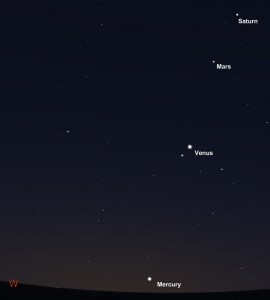
If you are new to astronomy, one of the first questions you are likely to ask is “What is that bright flickering star I can see above the Western horizon as the sky is getting dark?”. That is Venus. The reason for it flickering has to do with the light from it being ‘bent’ or broken into the individual colours of the rainbow/spectrum by the Earth’s atmosphere as it starts to set. The lower down an object is the more atmosphere the light has to travel through. Add in a bit of wind in the upper atmosphere and you start to get a ‘star’ which can change colour and make people wonder if they are seeing a UFO. They aren’t. It is just Venus.
Jupiter can easily visible as a bright star above the Eastern horizon from around 11pm onwards. With binoculars (at least 10 by 50’s), and a bit of patience you will be able to locate the planet Uranus. In spite of it’s significant size, Uranus is not very impressive – even in a large amateur telescope. It is just too far away.
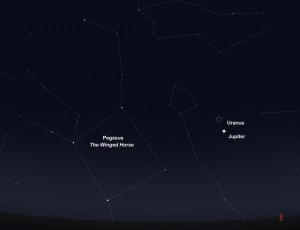
Sunday 11 July 2010
Look above the Western horizon and you will easily be able to see Venus. It is the brightest object in the night sky (excluding the International Space Station when it is flaring!). Venus is located to the right of the star Regulus (the brightest star in the ancient Greek constellation Leo the Lion).
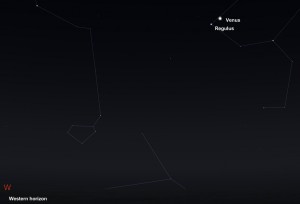
Monday 12 July 2010
New Moon 5.40 am AEST
A Total Solar Eclipse will be visible over much of the southern Pacific Ocean, touching several small islands including Tuamotu in French Polynesia and Easter Island, as well as the southern tips of Argentina and Chile in South America.
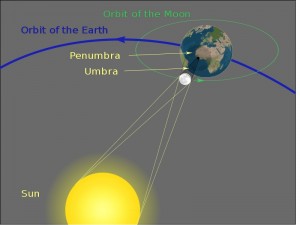
NASA has a special website for this eclipse here.

At the time of preparing this post, I could only find one webcast of this eclipse. Given that the Moon’s shadow is sweeping across the Pacific Ocean, that is hardly surprising. The Total Solar Eclipse is being webcast from Easter Island by a Japanese team that travels around the world webcasting Solar Eclipses. They are using the Ustream.tv service to host the webcast. From what I can gather (using Google Translate), the actual time of Total Eclipse occurs on Easter Island at 6.11am AEST on 12 July 2011. From the capital of Easter Island ( Hanga Roa, totality lasts 4 minutes 41 seconds with the Sun 40° above the horizon). I suggest you log on to the webcast website before that time to ensure you can get a connection.
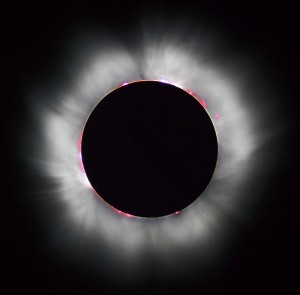
Tuesday 13 July 2010
Moon at perigee 9pm AEST
Look low above the Western horizon during evening twilight for a very thin Crescent Moon and the planet Mercury. Binoculars are highly recommended.
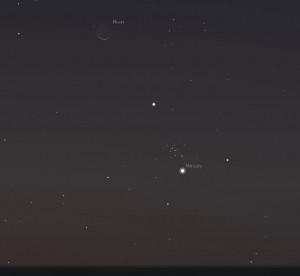
Wednesday 14 July 2010
Low low above the Western horizon to see a slim crescent Moon, the star Regulus (the brightest star in the ancient Greek constellation Leo the Lion) and Venus in a very crooked line.
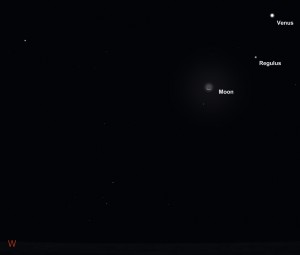
Thursday 15 July 2010
Venus, the Crescent Moon and Mars make a temporary triangle above the Western horizon in evening twilight.

Friday 16 July 2010
Mars, Saturn and the Crescent Moon make a temporary triangle above the Western horizon.
Saturday 17 July 2010
The Crescent Moon and the planets Mars, Saturn, Venus and Mercury now form a very crooked line above the North Western horizon.
For Further Information
Planet and Moon Rise/Set Times
Planet and Moon rise/set times for 2010 can be found here on this website.
Customised Astronomy & Satellite Viewing information
Information on how to obtain customised astronomy & satellite viewing information for your location can be found here on this website.
Great Red Spot (Jupiter) viewing times
Information on when to see the Great Red Spot on Jupiter in 2010 can be found here on this website. Keep in mind that Jupiter is currently only visible in the morning sky.